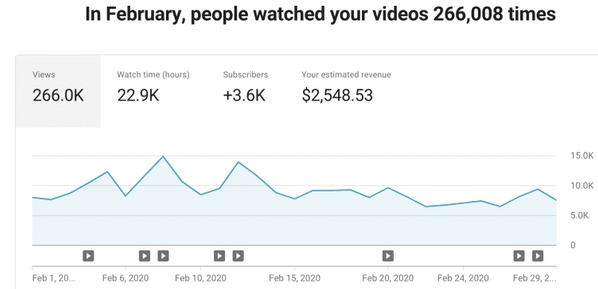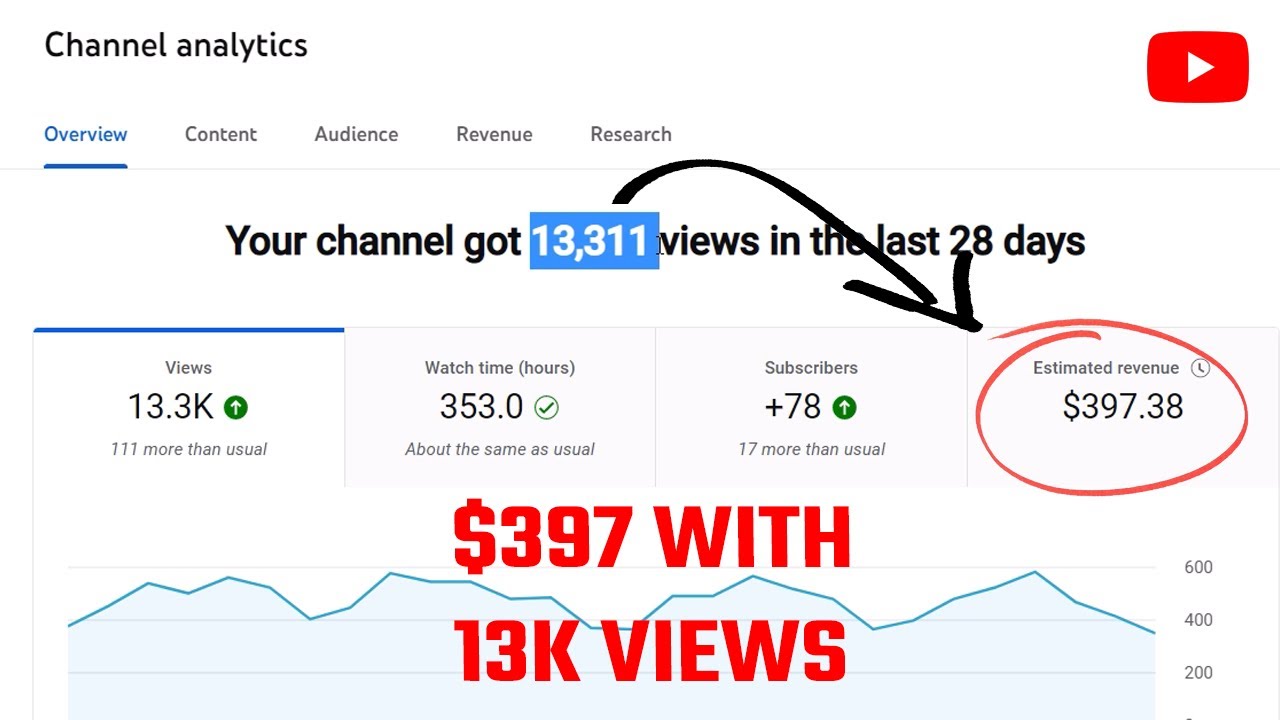YouTube monetization can seem a bit like a mystical world filled with endless opportunities for creators. If you’ve ever wondered how channels earn money and what it takes to cash in on those views, you're not alone! In this blog post, we'll break down the different ways you can earn through YouTube by focusing on a significant milestone: 30 million views. It’s all about turning creativity into cash while understanding the revenue streams available. From ad revenue to sponsorship deals, let’s dive into the fascinating world of
The Factors Influencing YouTube Earnings

When it comes to YouTube earnings, several factors play a role in how much you can make. Simply having 30 million views doesn't guarantee you a specific income. Let’s explore these influencing factors in more detail:
- Ad Revenue: Most YouTube earnings come from ad revenue, which varies depending on the number of ads shown, viewer location, and the types of ads. CPM (cost per thousand views) can range from $0.25 to over $10.
- Viewer Demographics: The age, location, and interests of your audience can significantly influence ad rates. For example, viewers from the USA or Canada typically generate higher ad revenue compared to those from other countries.
- Content Type: Different niches perform differently in terms of monetization. For example, finance and technology channels often command higher CPM rates than entertainment channels.
- Sponsorships: Brands often partner with creators for sponsored content. These deals can range widely, from hundreds to millions, depending on your channel's reach and influence.
- Memberships and Merchandise: Some creators earn extra income through channel memberships and merchandise sales, creating additional revenue streams beyond traditional ads.
- Video Length: Longer videos can include more ads, potentially increasing overall ad revenue. YouTube allows mid-roll ads for videos longer than 8 minutes.
- Engagement Rate: High engagement rates (likes, comments, shares) can boost visibility and attract more advertisers, which influences overall earnings.
So, with 30 million views, putting these factors into perspective is crucial for understanding potential earnings. It’s a mix of audience engagement and the right monetization strategies that can elevate a channel's income!
Calculating Revenue from 30 Million Views

When you think about 30 million views on YouTube, it’s hard not to get excited! But how much does that actually translate into earnings? The answer is not as straightforward as you might think, as there are various factors at play.
To estimate revenue, creators typically look at the concept of CPM, or Cost Per Thousand Impressions. This varies widely, but on average, it can range from $1 to $10. That said, it’s essential to consider the following elements:
- Geography: Views from countries like the USA or Canada often yield higher CPMs than views from countries with lower ad spend.
- Content Type: Some niches, like finance or technology, may attract higher-paying advertisers than entertainment or vlogs.
- Engagement Metrics: Videos that keep viewers watching longer can have a higher chance of serving ads, which boosts potential revenue.
Let’s do a simple calculation assuming an average CPM of $5:
| Metrics | Values |
|---|---|
| Views | 30,000,000 |
| CPM ($) | 5 |
| Total Revenue ($) | 150,000 |
So, in this hypothetical scenario, 30 million views could generate around $150,000. However, it’s crucial to remember that this is an estimate, and actual earnings can vary significantly!
Different Revenue Models on YouTube

YouTube isn’t just about ad revenue, although that’s the most commonly talked-about earnings model. Let’s dive into several revenue streams available for creators looking to monetize their content.
- Ad Revenue: This is the traditional model where advertisers pay to show ads before, during, or after your videos. As we've discussed, CPM plays a critical role here.
- Channel Memberships: If you have over 30,000 subscribers (or 1,000 for gaming channels), you can offer memberships for a monthly fee. This gives fans exclusive perks, and you keep a portion of the membership fees!
- Super Chat and Super Stickers: During live streams, viewers can pay to have their messages or stickers highlighted in the chat. It’s a fun way for fans to engage and support creators directly.
- Selling Merchandise: Many creators take advantage of their audience by selling everything from t-shirts to mugs, either through YouTube’s integrated merch shelf or external websites.
- Sponsored Content: Collaborating with brands can be highly lucrative. You create a video featuring their product or service, and they pay you for the promotion, often overshadowing traditional ad revenue.
It’s important to explore these varied revenue models, as they can significantly enhance earnings potential and create multiple income streams. Ultimately, the right mix depends on your content, audience, and niche.
Real-Life Examples of YouTube Earners
When we talk about YouTube earnings, it's always fascinating to look at real-life examples of creators who've made a significant impact. These individuals not only entertain but also generate substantial income from their content. Let’s explore a few notable YouTube earners and the strategies that led to their financial success.
- PewDiePie: With over 110 million subscribers, PewDiePie has become synonymous with YouTube success. His main earnings come from ad revenue, sponsorships, and merchandise sales. He has revealed in various interviews that his earnings can range anywhere from $3,000 to $5,000 per million views. For 30 million views, that could mean an estimated income of $90,000 to $150,000.
- MrBeast: Known for his extravagant challenges and philanthropic efforts, MrBeast has taken YouTube by storm. His unique business model includes not just ad revenue but also sponsorships and brand deals. He can earn upwards of $5,000 per million views, resulting in potential earnings of $150,000 for 30 million views.
- Lilly Singh: A former YouTube star turned late-night talk show host, Lilly Singh has built a brand around her channel. While her income varies greatly, she started with ad revenue and sponsored content, estimating $3,000 to $6,000 per million views, translating to $90,000 to $180,000 for 30 million views.
These examples highlight how diverse strategies and content styles lead to varying income levels on YouTube, showing that there's no one-size-fits-all approach.
Maximizing Revenue on YouTube
So, how can you maximize your revenue on YouTube? Whether you're just starting or have been creating content for a while, there are several strategies you can implement to increase your earnings.
| Strategy | Description |
|---|---|
| Optimize Video Content | Focus on quality and engagement! Create content that resonates with your audience. Higher quality leads to longer watch times and more ad exposure. |
| Leverage SEO | Use keywords in titles, descriptions, and tags. Studies show that effective SEO can significantly boost your video’s visibility. More views equal more ads! |
| Engage with Your Audience | Build a community by responding to comments and asking for feedback. Engaged viewers are more likely to return, increasing your view count and revenue potential. |
| Explore Multiple Revenue Streams | Diversify income by incorporating brands’ sponsorships, affiliate marketing, and merchandise. Don’t solely rely on ad revenue! |
By employing these strategies, creators can not only enhance their content but also increase their earnings potential, making the YouTube journey even more rewarding.
Understanding YouTube Earnings for 30 Million Views
YouTube has become a lucrative platform for content creators worldwide, offering opportunities to monetize their videos through advertisements and other revenue streams. The potential earnings from achieving 30 million views can vary significantly based on several factors. Below, we will break down the main components that influence YouTube earnings.
One of the key factors in determining earnings is the *Cost Per Mille (CPM), which is the amount advertisers pay per 1,000 views. CPM rates can fluctuate widely based on the niche, geographic location, and seasonality. Here’s a breakdown of typical CPM ranges:
| Niche | Average CPM ($) |
|---|---|
| Health & Fitness | $10 - $30 |
| Technology | $5 - $15 |
| Education | $2 - $10 |
| Entertainment | $1 - $5 |
To calculate the potential earnings from 30 million views, you can use the following formula:
Earnings = (CPM x Views) / 1000
For example, with a CPM of $10, earnings would be:
(10 x 30,000,000) / 1000 = $300,000
Another consideration is the YouTube Partner Program*, which allows creators to earn through channel memberships, Super Chat, and merchandise shelf features. Additional income can also come from sponsorships and affiliate marketing.
In summary, while the earnings from 30 million views can vary widely, understanding the factors such as CPM, niche, and additional revenue streams is crucial for content creators aiming to maximize their YouTube income.
Conclusion: The Potential of YouTube Income
The potential of YouTube income is vast, with the possibility of earning from multiple streams, making it a highly attractive platform for dedicated content creators who leverage their audience effectively.
 admin
admin








